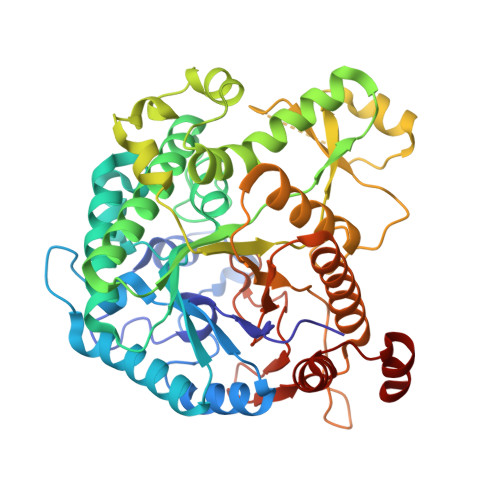A novel beta-glucosidase isolated from the microbial metagenome of Lake Poraque (Amazon, Brazil).
Toyama, D., de Morais, M.A.B., Ramos, F.C., Zanphorlin, L.M., Tonoli, C.C.C., Balula, A.F., de Miranda, F.P., Almeida, V.M., Marana, S.R., Ruller, R., Murakami, M.T., Henrique-Silva, F.(2018) Biochim Biophys Acta 1866: 569-579
- PubMed: 29454992
- DOI: https://doi.org/10.1016/j.bbapap.2018.02.001
- Primary Citation of Related Structures:
5WKA - PubMed Abstract:
The Amazon region holds most of the biological richness of Brazil. Despite their ecological and biotechnological importance, studies related to microorganisms from this region are limited. Metagenomics leads to exciting discoveries, mainly regarding non-cultivable microorganisms. Herein, we report the discovery of a novel β-glucosidase (glycoside hydrolase family 1) gene from a metagenome from Lake Poraquê in the Amazon region. The gene encodes a protein of 52.9 kDa, named AmBgl-LP, which was recombinantly expressed in Escherichia coli and biochemically and structurally characterized. Although AmBgl-LP hydrolyzed the synthetic substrate p-nitrophenyl-β-d-glucopyranoside (pNPβG) and the natural substrate cellobiose, it showed higher specificity for pNPβG (k cat /K m = 6 s -1 ·mM -1 ) than cellobiose (k cat /K m = 0.6 s -1 ·mM -1 ). AmBgl-LP showed maximum activity at 40 °C and pH 6.0 when pNPβG was used as the substrate. Glucose is a competitive inhibitor of AmBgl-LP, presenting a K i of 14 mM. X-ray crystallography and Small Angle X-ray Scattering were used to determine the AmBgl-LP three-dimensional structure and its oligomeric state. Interestingly, despite sharing similar active site architecture with other structurally characterized GH1 family members which are monomeric, AmBgl-LP forms stable dimers in solution. The identification of new GH1 members by metagenomics might extend our understanding of the molecular mechanisms and diversity of these enzymes, besides enabling us to survey their industrial applications.
Organizational Affiliation:
Laboratory of Molecular Biology, Department of Genetics and Evolution, Federal University of São Carlos, SP, Brazil.
















